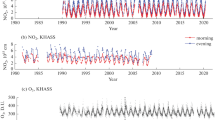Abstract
Three-year summertime surface atmospheric N2O concentrations were observed for the first time on the Fildes Peninsula, maritime Antarctica, and the relationships among the N2O concentration, total atmospheric O3 amount, and sunspot number were analyzed. Solar activity had an important effect on surface N2O concentration and total O3 amount, and increases of sunspot number were followed by decreases in the N2O concentration and total O3 amount. A corresponding relationship exists between the N2O concentration and total atmospheric O3, and ozone destruction was preceded by N2O reduction. We propose that the extended solar activity in the Antarctic summer reduces the stratospheric N2O by converting it into NO x , increases the diffusion of N2O from the troposphere to the stratosphere, decreases the surface atmospheric N2O, and depletes O3 via the chemical reaction between O3 and NO x . Our observation results are consistent with the theory of solar activity regarding the formation of the Antarctic O3 hole.
Similar content being viewed by others
References
Bian Jianchun, Chen Hongbin, Zhao Yanliang, and Lu Daren, 2002: Variation features of total atmospheric ozone in Beijing and Kunming based on Dobson and TOMS data.Adv. Atmos. Sci.,19(2), 279–286.
Brasseur, G., and S. Solomon, 1984:Aeronomy of the Middle Atmosphere. D. Reidel Publishing Company, Hingham, Mass, 373pp.
Callis, L. B., and M. Natarajan, 1986: The Antarctic ozone minimum: Relationship to odd chlorine, the final warming, and the 11-year solar cycle.J. Geophys. Res.,91, 10771–10796.
Collins, Jr. J. E., and coauthors, 1996: Airborne nitrous oxide observations over the western Pacific Ocean: September–October 1991.J. Geophys. Res.,101(D1): 1975–1984.
Crutzen, P., 1970: The influence of nitrogen oxides on the atmospheric ozone content.Quart. J. Roy. Meteor. Soc.,96, 320–325.
Crutzen, P., and D. Ehhalt, 1977: Effects of nitrogen and combustion on the stratospheric ozone layer.Ambio,6, 112–117.
Dobbie, K. E., I. P. McTaggart, and K. A. Smith, 1999: Nitrous oxide emissions from intensive agricultural systems: Variations between crops and seasons, key driving variables, and mean emission factors.J. Geophys. Res.,104(NO. D21), 26891–26899.
Fahey, D. W., and A. R. Ravishankara, 1999: Summer in the stratosphere.Science,285, 208–210.
Fahey, D. W., and coauthors, 2000: Ozone destruction and production rates between spring and autumn in the Arctic stratosphere.Geophys. Res. Lett.,27(17), 2605–2608.
Farman, J. G., B. G. Gardiner, and J. D. Shanklin, 1985: Large losses of total ozone in Antarctica reveal seasonal ClOx/NO x interaction.Nature,315, 207–210.
IPCC, 1992:Climate Change: The Supplementary Report to the IPCC Scientific Assessment. J. T. Houghton et al., Eds., Cambridge University Press, New York, 278.
Ishijima, K., T. Nakazawa, S. Sugawara, S. Aoki, and T. Saeki, 2001: Concentration variations of tropospheric nitrous oxide over Japan.Geophys. Res. Lett.,28(1), 171–174.
Kondo, Y., and coauthors, 1999: NOy-N2O correlation observed inside the Arctic vortex in February 1997: Dynamical and chemical effects.J. Geophys. Res.,104(D7), 8215–8224.
Martin, I. M., T. Toroshelidze, W. E. Alves, M. G. S. Mello, A. A. Gusev, and G. I. Pugacheva, 1999: Solar cycle and global long term variations of stratospheric ozone.Adv. Space. Res.,24(5), 665–669.
McElroy, M., and J. McConnell, 1971: Nitrous oxide: A natural source of stratospheric NO.J. Atmos. Sci.,28, 1095–1098.
Mosier, A. R., D. S. Schimel, D. Valentine, K. Bronson, and W. Parton, 1991: Methane and nitrous oxide fluxes in native, fertilized and cultivated grasslands.Nature,350, 330–332.
Portmann, R. W., S. S. Brown, T. Gierczak, R. K. Talukdar, J. B. Burkholder, and A. R. Ravishankara, 1999: Role of nitrogen oxides in the stratosphere: A reevaluation based on laboratory studies.Geophys. Res. Lett.,26(15), 2387–2390.
Priscu, J. C., 1997: The biogeochemistry of nitrous oxide in permanently ice-covered lakes of the McMurdo Dry Valleys, Antarctica.Global Change Biology,3(4), 301–315.
Priscu, J. C., M. T. Downes, and C. P. McKay, 1996: Extreme supersaturation of nitrous oxide in a poorly ventilated Antarctic lake.Limnology and Oceanography,41(7), 1544–1551.
Reid, S. J., A. F. Tuck, and G. Liladis, 2000: On the changing abundance of ozone minima at northern midlatitudes.J. Geophys. Res.,105(D10), 12169–12180.
Solomon, S., R. R. Garcia, F. S. Rowland, and D. J. Wuebbles, 1986: On the depletion of Antarctic ozone.Nature,321, 755–758.
Sun Liguang, Zhu Renbin, Xie Zhouqing, Xing Guangxi, 2002: Emissions of nitrous oxide and methane from Antarctic tundra: Role of penguin dropping deposition.Atmos. Environ.,36, 4977–4982.
Sun Liguang, Xie Zhouqing, Zhao Junlin, Xing Guangxi, Shi Shulian, and Du Lijuan, 2000: Monitoring the concentration of N2O in the Fildes Peninsula, maritime Antarctica.Chinese Science Bulletin,45(5), 1195–1199.
Tung, Ka-kit, K. W. Malcolm, and K. Jose, 1986: Are Antarctic ozone variations a manifestation of dynamics or chemistry?Nature,322, 811–814.
Xing Guangxi, 1998: N2O emission from cropland in China.Nutrient Cycle in Agroecosystem,52, 249–254.
Xing Guangxi, and Zhu Zhaoliang, 1997: Prelimilary studies on N2O emission fluxes from upland soil and paddy soils in China.Nutrient Cycling in Agroeco systems,49, 249–254.
Yoshiro, S., 1986: Antarctic ozone change correlated to the stratospheric temperature field.Geophys. Res. Lett. 13(12), 134–137.
Zhang Yongping, and Lu Longhua, 1999: The review on the studies for Antarctic ozone hole.Chinese Journal of Polar Research,2(2), 67–78. (in Chinese)
Zhu Renbin, Sun Liguang, and Liu Xiaodong, 2003: Atmospheric nitrous oxide observations above the oceanic surface during CHINARE-18.Progress in Natural Science,13(8), 615–619.
Author information
Authors and Affiliations
Rights and permissions
About this article
Cite this article
Zhu, R., Sun, L., Yin, X. et al. Summertime surface N2O concentration observed on fildes Peninsula Antarctica: Correlation with total atmospheric O3 and solar activity. Adv. Atmos. Sci. 21, 204–210 (2004). https://doi.org/10.1007/BF02915706
Received:
Revised:
Issue Date:
DOI: https://doi.org/10.1007/BF02915706




